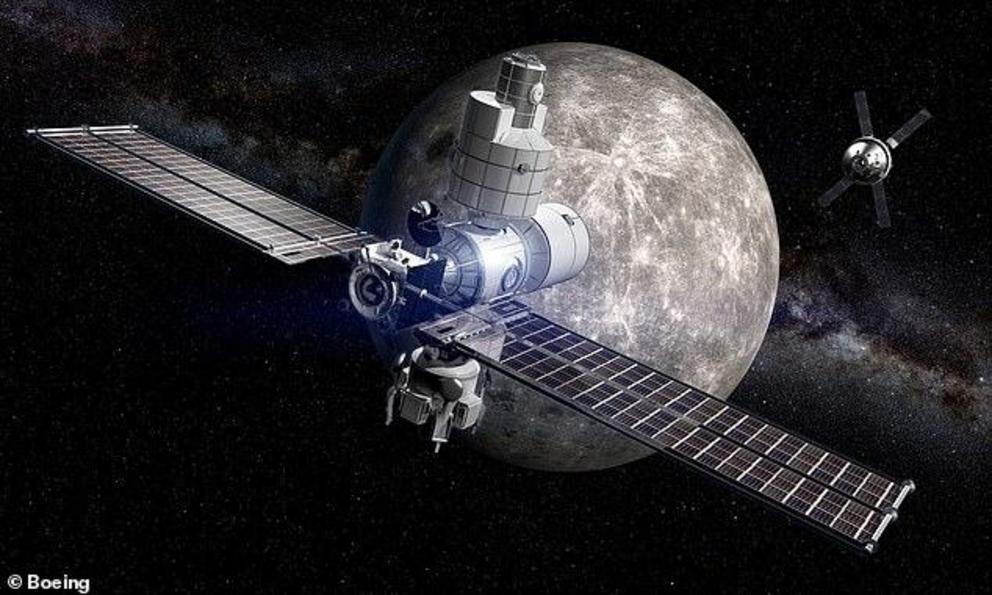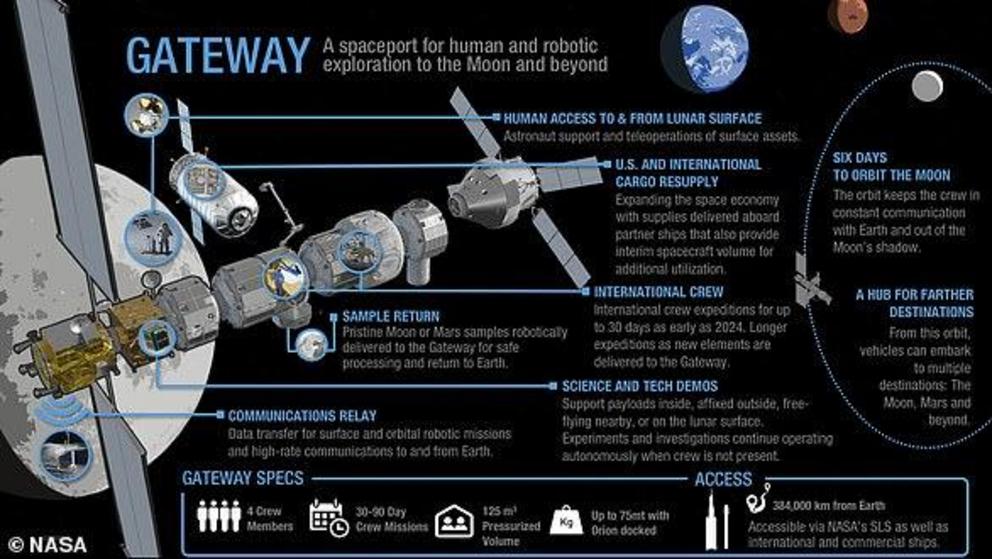Airbus is developing a 9-tonne living quarters and research lab module for astronauts
Aerospace company Airbus is to draw up plans for Europe's contribution to a base orbiting the moon.
The Gateway is an international project that envisages a lunar staging post for manned space missions to the moon or Mars.
The European Space Agency (ESA) has commissioned Airbus, which has a major space facility in Stevenage, to develop key concepts for the station over the next 15 months.
The first study will look at designs for a habitation and research module measuring around 6.5 metres (21ft) and weighing nine tonnes.
Airbus will also consider plans for refuelling, docking and telecommunications infrastructure.

The Gateway (artist's impression) is an international project that envisages a lunar staging post for manned space missions to the moon or Mars
The company's Defence and Space division builds advanced satellites and spacecraft at its assembly plant in Stevenage.
BepiColombo, a European spacecraft due to blast off on a journey to the planet Mercury on Saturday, was built there.
The US, Russia, Canada, Japan, and Europe all have a role in the Gateway project, led by the American space agency Nasa.
Nasa plans to launch the base's central power propulsion element (PPE) into lunar orbit in the early 2020s.
David Parker, director of human and robotic exploration at ESA, said: 'With these studies and other preparations, ESA aims to stay at the centre of human space exploration.
'The Gateway will become humanity's most remote research outpost and we hope Europe will benefit from the world of innovation, discovery and excitement that lies ahead.'
Unlike the International Space Station (ISS), the Gateway will not be continually manned.
WHAT IS THE LUNAR GATEWAY?
Russia and the United States are cooperating on a NASA-led project to build the first lunar space station, codenamed the Lunar Gateway.
The agreement, signed in September 2017, is part of a long-term project to send humans to Mars.
The crew-tended spaceport will orbit the moon and serve as a 'gateway to deep space and the lunar surface,' NASA has said.
The first modules of the station could be completed as soon as 2024.

Russia and the United States are cooperating on a NASA-led project to build the first lunar space station, codenamed the Lunar Gateway
An international base for lunar exploration for humans and robots and a stopover for spacecraft is a leading contender to succeed the $100 billion International Space Station (ISS), the world's largest space project to date.
Nasa asked European scientists and industry leaders to join the agency in September 2018.
Accepting the offer could cost the European Space Agency (ESA) - of which Britain is a key member - an estimated £1 billion ($1.3 billion).
A decision on whether to become involved will be taken at a meeting of European science ministers next year.
In the mean time, the ESA is drawing up plans for the form its section of the station could take.
It is intended to act as a staging post for human space exploration and crewed when needed.
Russia and the US first signed an agreement to work on the project in September 2017.
The project envisages building a crew-tended spaceport in lunar orbit that would serve as a 'gateway to deep space and the lunar surface,' NASA has said.
The agency said the agreement reflected the two agencies' common vision for human exploration.
'While the deep space gateway is still in concept formulation, NASA is pleased to see growing international interest in moving into cislunar space as the next step for advancing human space exploration,' Robert Lightfoot, acting administrator at NASA headquarters in Washington, said.

The European Space Agency (ESA) has commissioned Airbus, which has a major space facility in Stevenage, to develop key concepts for the station (artist's impression) over the next 15 months
A base for lunar exploration for humans and robots and a stopover for spacecraft is a leading contender to succeed the International Space Station (ISS)
Construction of the ISS, which is the world's largest space project to date, took 13 years to complete at a cost of an estimated £75 billion ($100 billion).
The Russians and Nasa are now cooperating to build the systems needed to organise scientific missions in lunar orbit and to the surface of the moon.
Nasa asked European scientists and industry leaders to join the agency in September 2018.
Accepting the offer could cost the European Space Agency (ESA) - of which Britain is a key member - an estimated £1 billion ($1.3 billion).
A decision on whether to become involved will be taken at a meeting of European science ministers next year.
In the mean time, the ESA is drawing up plans for the form its section of the station could take.
For full references please use source link below.
